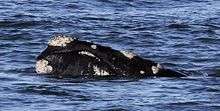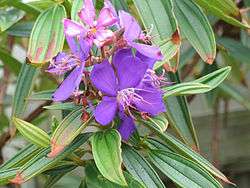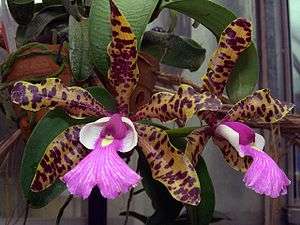Wildlife of Brazil
The wildlife of Brazil comprises all naturally occurring animals, plants, and fungi in the South American country. Home to 60% of the Amazon Rainforest, which accounts for approximately one-tenth of all species in the world,[1] Brazil is considered to have the greatest biodiversity of any country on the planet. It has the most known species of plants (55,000), freshwater fish (3,000), and mammals (over 689).[2] It also ranks third on the list of countries with the most bird species (1,832) and second with the most reptile species (744).[2] The number of fungal species is unknown but is large.[3] Approximately two-thirds of all species worldwide are found in tropical areas, often coinciding with developing countries such as Brazil. Brazil is second only to Indonesia as the country with the most endemic species.[4]
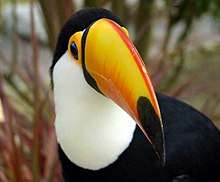
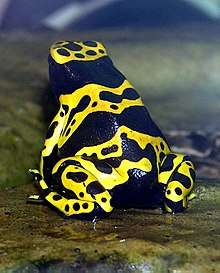
Biodiversity
In the animal kingdom, there is general consensus that Brazil has the highest number of both terrestrial vertebrates and invertebrates of any country in the world.[5] This high diversity of fauna can be explained in part by the sheer size of Brazil and the great variation in ecosystems such as Amazon Rainforest, Atlantic Forest and Cerrado. The numbers published about Brazil's fauna diversity vary from source to source, as taxonomists sometimes disagree about species classifications, and information can be incomplete or out-of-date. Also, new species continue to be discovered and some species go extinct in the wild. Brazil has the highest diversity of primates (78species) and freshwater fish (over 3000 species) of any country in the world.[5] It also claims the highest number of mammals with 524 species,[5] the second highest number of amphibians with 517 species and butterflies with 3,150 species,[5] the third highest number of birds with 1,622 species,[5] and fifth number of reptiles with 468 species.[5] There is a high number of endangered species,[6] many of which live in threatened habitats such as the Atlantic Forest or the Amazon Rainforest.
Scientists have described between 96,660 and 128,843 invertebrate species in Brazil.[7] According to a 2005 estimate by Thomas M. Lewinsohn and Paulo I. Prado, Brazil is home to around 9.5% of all the species and 13.1% of biota found in the world; these figures are likely to be underestimates according to the authors.[7]
Enough is known about Brazilian fungi to say with confidence that the number of native species must be very high and very diverse: in work almost entirely limited to the state of Pernambuco, during the 1950s, 1960s and early 1970s, more than 3300 species were observed by a single group of mycologists[3] Given that current best estimates suggest only about 7% of the world's true diversity of fungal species has so far been discovered, with most of the known species having been described from temperate regions,[8] the number of fungal species occurring in Brazil is likely to be far higher.
Because it encompasses many species-rich ecosystems for animals, fungi and plants, Brazil houses many thousands of species, with many (if not most) of them still undiscovered. Due to the relatively explosive economic and demographic rise of the country in the last century, Brazil's ability to protect its environmental habitats has increasingly come under threat. Extensive logging in the nation's forests, particularly the Amazon, both official and unofficial, destroys areas the size of a small country each year, and potentially a diverse variety of plants and animals.[9] However, as various species possess special characteristics, or are built in an interesting way, some of their capabilities are being copied for use in technology (see bionics), and the profit potential may result in a retardation of deforestation.
Ecoregions
Brazil's immense area is subdivided into different ecoregions in several kinds of biomes. Because of the wide variety of habitats in Brazil, from the jungles of the Amazon Rainforest and the Atlantic Forest (which includes Atlantic Coast restingas), to the tropical savanna of the Cerrado, to the xeric shrubland of the Caatinga, to the world's largest wetland area, the Pantanal, there exists a wide variety of wildlife as well.
Animals
Terrestrial mammals and reptiles
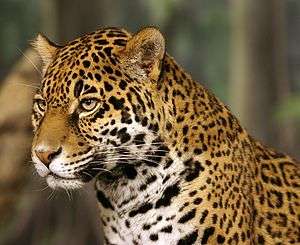
The wild canids found in Brazil are the maned wolf, bush dog, hoary fox, short-eared dog, crab-eating fox and pampas fox. The felines found in Brazil are the jaguar, the puma, the margay, the ocelot, the oncilla, and the jaguarundi. Other notable animals include the giant anteater, several varieties of sloths and armadillos, coati, giant river otter, tapir, peccaries, marsh deer, Pampas deer, and capybara (the world's largest existing rodent).[2] There are around 75 primate species, including the howler monkey, the capuchin monkey, and the squirrel monkey, the marmoset, and the tamarin.[2]
Brazil is home to the anaconda, frequently described, controversially, as the largest snake on the planet. This water boa has been measured up to 30 feet (9.1 m) long, but historical reports note that native peoples and early European explorers claim anacondas from 50 to 100 feet (30 m) long.[10][11]
Invertebrates
There are 1107[12] known species of non-marine molluscs living in the wild in Brazil.
The second largest spider in the world, the Goliath birdeater (Theraphosa blondi), can be found in some regions of Brazil.[13]
Insects
It is calculated that Brazil has more insects than any country in the world. It is estimated as having over 70,000 species of insects,[14] with some estimates ranging up to 15 million,[5] with more being discovered almost daily. One 1996 report estimated between 50,000 and 60,000 species of insects and spiders in a single hectare of rainforest.[15] About 520 thysanoptera species belonging to six families in 139 genera are found in Brazil.[16]
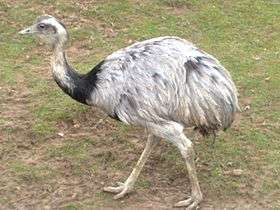
Birds
Brazil ranks third on the list of countries, behind Colombia and Peru, with the most number of distinct bird species, having 1622 identified species,[2] including over 70 species of parrots alone. It has 191 endemic birds.[5] The variety of types of birds is vast as well, and include birds ranging from brightly colored parrots, toucans, and trogons to flamingos, ducks, vultures, hawks, eagles, owls, swans, and hummingbirds. There are also species of penguins that have been found in Brazil.[17]
The largest bird found in Brazil is the rhea, a flightless ratite bird, similar to the emu.
Aquatic and amphibian
Brazil has over 3,000 identified species of freshwater fish and over 500 species of amphibians.[5] As elsewhere in South America, the majority of the freshwater fish species are characiforms (tetras and allies) and siluriforms (catfish), but there are also many species from other groups such as the cyprinodontiforms and cichlids. While the majority of Brazil's fish species are native to the Amazon, the Paraná–Paraguay and the São Francisco river basins, the country also has an unusually high number of troglobitic fish, with 25 species (15% of the total in the world) known so far.[18] The most well-known fish in Brazil is the piranha.[19]
Other aquatic and amphibian animals found in Brazil include the pink dolphin (the world's largest river dolphin), the caimans (such as the black caiman), and the pirarucu (one of the world's largest river fish). Also familiar are the brightly colored poison dart frogs.
Fungi
The diversity of Brazil's fungi - even the small amount known so far to scientists - is astonishing. Using only conventional microscopy, and examining living leaves collected from various plants, the mycologist Batista and his colleagues, working in Pernambuco in the 1950s, 1960s and 1970s, regularly recorded more than one fungal species, and sometimes up to ten on a single leaf.[3] Although information about fungi worldwide remains very fragmented, a preliminary estimate, based only on the work of Batista, shows that the number of potentially endemic fungal species in Brazil already exceeds 2000. Also, fungi is very often spot in Brazil.[20]
Plants
Brazil has 55,000 recorded plant species, the highest number of any country.[2] About 30% of these species are endemic to Brazil.[5] The Atlantic Forest region is home to tropical and subtropical moist forests, tropical dry forests, tropical savannas, and mangrove forests. The Pantanal region is a wetland, and home to a known 3,500 species of plants. The Cerrado is biologically the most diverse savanna in the world.
The Pau-brasil tree (also known as Brazilwood) was a common plant found along the Atlantic coast of Brazil. But excessive logging of the prized timber and red dye from the bark pushed the Pau-brasil towards extinction. However, since the inception of synthetic dyes, the Pau-Brazil has been harvested less. The Pau-brasil tree is sometimes mentioned as the origin of the country's name.[21][22]
All over Brazil, in all biomes, are hundreds of species of orchids, including those in the genera Cattleya, Oncidium, and Laelia.
Along the border with Venezuela lies Monte Roraima, home to many carnivorous plants. The plants evolved to digest insects due to the oligotrophic (low level of nutrients) soil of the tepui.[23]
List of plants by ecoregion:
- List of plants of Amazon Rainforest vegetation of Brazil
- List of plants of Atlantic Forest vegetation of Brazil
- List of plants of Caatinga vegetation of Brazil
- List of plants of Cerrado vegetation of Brazil
- List of plants of Pantanal vegetation of Brazil
Threats to wildlife
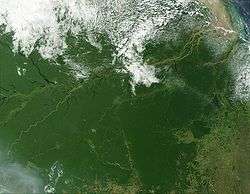
More than one-fifth of the Amazon Rainforest in Brazil has been completely destroyed, and more than 70 mammals are endangered.[2] The threat of extinction comes from several sources, including deforestation and poaching. Extinction is even more problematic in the Atlantic Forest, where nearly 93% of the forest has been cleared.[25] Of the 202 endangered animals in Brazil, 171 are in the Atlantic Forest.[26] Currently, 15.8 million acres of tropical ecosystem have been completely eliminated to farm sugarcane for ethanol production. And additional 4.5 million acres is planned to be planted during the next four years. 70-85% of Brazil's transportation energy is derived from ethanol, or various mixtures of ethanol and petroleum-based fuels. Only about 15-20% comes from imported petroleum. This massive national biofuel program has been devastating to tropical wildlife diversity, and to the global climate/environment.[27] Article 1 With its acquisition of BioEnergia, BP (British Petroleum) is planning to further expand Brazil's ethanol program. BP - BioEnergia
National emblems
| National bird | Rufous-bellied thrush (sabiá)[28] |
| National flower | Ipê-amarelo – Tecoma chrysostricha[29] |
| National tree | Pau-Brasil – Caesalpinia echinata[21] |
See also
References
- "Amazon - World's largest tropical rain forest and river basin". World Wide Fund for Nature. Retrieved 2010-06-03.
- Palmerlee, Danny (2007). South America on a Shoestring. Lonely Planet Publications. p. 275. ISBN 978-1-74104-443-0. OCLC 76936293.
- Da Silva, M. and D.W. Minter. 1995. Fungi from Brazil recorded by Batista and Co-workers. Mycological Papers 169. CABI, Wallingford, UK. 585 pp.
- Chapman, A.D (September 2005). "Numbers of Living Species in Australia and the World: A Report for the Department of the Environment and Heritage". Australian Biological Resources Study. Australian Biodiversity Information Services. Archived from the original on 2007-11-01. Retrieved 2007-11-26.
- Marco Lambertini (2000). "A Naturalist's Guide to the Tropics". Retrieved 2007-06-19.
- Ministério do Meio Ambiente. "Lista Nacional das Espécies da Fauna Brasileira Ameaçadas de Extinção" (in Portuguese). Retrieved 2007-06-20.
- Lewinsohn, Thomas M.; Paulo Inácio Prado (June 2005). "How Many Species Are There in Brazil?". Conservation Biology. 19 (3): 619–624. doi:10.1111/j.1523-1739.2005.00680.x.
- Kirk, P.M., P.F. Cannon, D.W. Minter and J. Stalpers. 2008. Dictionary of the Fungi. Edn 10. CABI, Wallingford, UK.
- USDA Forest Service website, Forest Service International Programs: Brazil, retrieved February 2007.
- "Which is the Biggest Snake?". Extreme Science. Retrieved 2007-12-05.
- "Eunectes murinus". Catalogue of Life: 2006 Annual Checklist. Retrieved 2007-12-05.
- Luiz Ricardo L. Simone. 2006. Land and Freshwater Molluscs of Brazil. Museu de Zoologia Universidade de São Paulo, São Paulo, Brazil. 390 pp. ISBN 85-906670-0-6. (book review)
- Benders-Hyde, Elisabeth. "Goliath Bird Eating Spider". Blue Planet Biomes. Retrieved 2007-12-05.
- "Brazil in Brief: Natural Resources". Embassy of Brazil - Ottawa. Retrieved 2007-12-05.
- Holmes, Bob; Gabrielle Walker (1996-09-21). "How did paradise begin?". New Scientist. Retrieved 2007-12-05.
- Renata Chiarini Monteiro. "The Thysanoptera fauna of Brazil" (PDF). CSIRO Entomology. Retrieved 2007-11-26.
- Magellanic Penguin, Organisation for the Conservation of Penguins.
- Rantin B., and M.E. Bichuette (2013). Phototactic behaviour of subterranean Copionodontinae Pinna, 1992 catfishes (Siluriformes, Trichomycteridae) from Chapada Diamantina, central Bahia, northeastern Brazil. International Journal of Speleology 41(1): 57-63
- Levitas, Gloria. "The Amazon's Kettle of Fish", New York Times, September 11, 1988.
- "Fungi of Brazil - potential endemics". Retrieved 2011-07-09.
- "Pau brasil profile". Global Trees Campaign. Archived from the original on 2007-08-31. Retrieved 2007-11-28.
- Kirkbride, Joseph H., Jr. (1995-06-11). "Brazil, National flower?". Plantbio Mailing List. Retrieved 2007-11-28.
- "Tepuis". Terrestrial Ecoregions. World Wildlife Fund. Retrieved 2007-11-28.
- "Visible Earth: The Amazon, Brazil". NASA. Retrieved 2007-11-28.
- "Places We Work: The Atlantic Forest of Brazil". The Nature Conservancy. 2007. Retrieved 2007-12-05.
- Capobianco, João Paulo. "Biodiversity in the Atlantic Forest". Brazil on CD-ROM and Internet. Ministry of External Relations. Retrieved 2007-12-05.
- Aljazeera / Brazil's Ethanol for SugarCane program
- "National Bird of Brazil: Sabià - Laranjeiro". Brazil Travel. Retrieved 2007-11-26.
- "National Symbols". Brazilian Embassy in Washington. Archived from the original on 2007-11-14. Retrieved 2007-11-26.
Sources
- Costa, L.P. et al. (2005). Mammal Conservation in Brazil. Conservation Biology 19(3): 672-679. [1]
- Comitê Brasileiro de Registros Ornitológicos. 2010. Lista das aves do Brasil. 9ª edição (18 de outubro de 2010). Disponível em <http://www.cbro.org.br>, accessada em 28 de dezembro de 2010.
Further reading
- Pearson, David L.; Les Beletsky (2002) [2001]. Brazil-Amazon and Pantanal. Ecotravellers Wildlife Guides. Academic Press. p. 275. ISBN 978-0-12-548052-9. OCLC 77711203.
External Links
- BrazilianFauna.com, a not-for profit educational website
- Brazil Nature: Ecosystem
- List of Brazilian animals on Encyclopedia of Life
